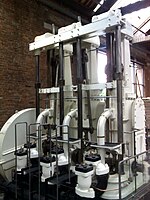Albert Bridge, Manchester

Albert Bridge is a Grade II listed skew arch bridge in Greater Manchester, England. A replacement for an earlier structure, New Bailey Bridge, it was completed in 1844. It crosses the River Irwell, connecting Salford to Manchester. An 1843 investigation of the earlier structure, built between 1783 and 1785, revealed that it was in such poor condition it would have to be completely replaced. A special committee decided on a design by George W. Buck, costing about £9,000. A temporary footbridge was provided while the new bridge was being built, although this was temporarily destroyed during a flood. In a separate incident, a construction worker was killed by falling masonry. The new bridge was opened on 26 August 1844. The first vehicle to cross was a donkey cart, from Manchester.
Excerpt from the Wikipedia article Albert Bridge, Manchester (License: CC BY-SA 3.0, Authors, Images).Albert Bridge, Manchester
Riverside Walk, Salford City Centre
Geographical coordinates (GPS) Address External links Nearby Places Show on map
Geographical coordinates (GPS)
| Latitude | Longitude |
|---|---|
| N 53.481808 ° | E -2.25309 ° |
Address
Albert Bridge
Riverside Walk
M3 5GN Salford, City Centre
England, United Kingdom
Open on Google Maps









